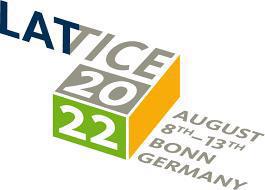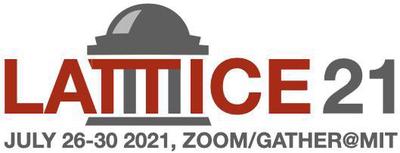Open lattice initiative (OpenLat)
This is an effort within the Lattice QCD community (started in 2019) for the production and sharing of dynamical gauge field ensembles to study physical phenomena of the strong interaction. We are aware that not every young researcher can be in the favourable position to belong to one of the big collaborations with access to large scale simulations to pursue new ideas. We want to close this gap by forming the present initiative centered around latest developments in the field. We offer partnership and access to (2+1)-flavour QCD gauge field ensembles produced from state-of-the-art QCD simulations with the new stabilised Wilson fermion action. This effort does not include master-field simulations which are based on the same lattice discretisation.

Latest News & Upcoming Talks
Our project was selected for a poster presentation at “High-Performance Computing in Science & Engineering: 26th Results and Review Workshop of the HLRS::
- On QCD simulations with stabilized Wilson fermions by J. Kim


Check out our contributions to the LATTICE23 conference:
- On the Progress in generating gauge ensembles with Stabilized Wilson Fermions by A. Francis
And more contributions to this year’s LATTICE23 conference featuring stabilized Wilson fermions and OpenLat ensembles:
- On the Towards hadronic 𝐷 decays at the SU(3) flavour symmetric point by M. Hansen
- On the Towards charm physics with stabilised Wilson Fermions by J. Kuhlmann

Check out our contributions to this year’s LATTICE22 conference:
- On the Master-field simulations of QCD and the exponential clover action by P. Fritzsch
- On the Benchmark Continuum Limit Results for Spectroscopy with Stabilized Wilson Fermions, by G. Pederiva
- On the Translating topological benefits in very cold master-field simulations by A.Francis
And more contributions to this year’s LATTICE22 conference featuring stabilized Wilson fermions:
- On the Update on the International Lattice Data Grid by F. Karsch
- On the Exploring distillation at the SU(3) flavour symmetric point by F. Joswig
- On the QCD Thermodynamics with stabilised Wilson fermions, by R. F. Basta
- On the On improvement and renormalisation of quark currents with stabilised Wilson fermions, by J. Kuhlmann
Lattice Action
We are simulating the tree-level Symanzik improved gauge action consisting of oriented plaquette $\mathcal{S}_0$ and double-plaquette $\mathcal{S}_1$ loops
$$S_G = \frac{1}{g_0^2}\sum_{k=0}^{1}c_k\sum_{\mathcal{C}\in\mathcal{S}_k}w_k(\mathcal{C})\mathrm{tr}\lbrace 1-U(\mathcal{C})\rbrace.$$
The weight factors $w_k(\mathcal{C})$ differ from 1 near the boundary, if any, and the pre-factors are $(c_0,c_1)=(\tfrac{5}{3},-\tfrac{1}{12})$. In line with current knowledge, we employ periodic boundary conditions for the gauge fields when simulating lattice spacings $a\gtrsim 0.06,\mathrm{fm}$, and open (Neumann) boundary conditions below that threshold to prevent topological freezing. In the latter case we set the (unknown) boundary on-shell improvement coefficient (entering $w_k$) to its tree-level value $c_\mathrm{G}=1$. Further details can be found in the documentation of openQCD (doc/gauge_action.pdf).
For the fermionic part of the action we choose $O(a)$ improved Wilson fermions with the new exponential Colver term, cf. ref. [1]. The corresponding Lattice–Dirac operator takes the form $D = D_w + m_0 + \delta D_v + \delta D_b$ where
$$D_w = \sum_{k=0}^{3}\tfrac{1}{2} \{ \gamma^{\vphantom{*}}_\mu(\nabla^{\vphantom{*}}_\mu+\nabla_\mu^{*})-\nabla^{*}_\mu\nabla_\mu^{\vphantom{*}}\},$$
and the volume (v) and boundary (b) improvement terms act on a spinor $\psi(x)$ in the following way
$$(\delta D_v + \delta D_b)\psi(x) = \left( 4+m_0 +(c_\mathrm{F}-1)\delta_{x_0,1}+(c_\mathrm{F}^\prime-1)\delta_{x_0,T-1} \right)$$
$$\hphantom{(\delta D_v + \delta D_b)\psi(x) = }\times\exp\left( \frac{c_\mathrm{sw}}{4+m_0}\sum_{\mu,\nu=0}^{3} \tfrac{i}{4}\sigma_{\mu\nu}\widehat{F}_{\mu\nu}(x)\right)\psi(x) -(4+m_0)\psi(x).$$
For the field strength of the gauge field, $\widehat{F}_{\mu\nu}$, the usual symmetric definition is taken. On-shell $O(a)$ improvement is achieved by setting the coefficients $c_\mathrm{F}$, $c_\mathrm{F}^\prime$ and $c_\mathrm{sw}$ to their non-perturbative values ($c_\mathrm{F}=c_\mathrm{F}^\prime=c_\mathrm{sw}=1$ at tree-level of perturbation theory). When simulating periodic gauge fields, the boundary conditions for the quark fields are taken to be anti-periodic while they are set to Schrödinger functional (SF), or Dirichlet, boundary conditions if the gauge fields obey open boundary conditions. In the periodic case no boundary improvement is necessary (i.e. $c_\mathrm{F}=c_\mathrm{F}^\prime=1$ above) while for SF bc.s one has $c_\mathrm{F}=c_\mathrm{F}^\prime$ with unknown coefficients. For that reason they are set to their tree-level values in our simulations. Addtional details can be found in the documentation of openQCD (doc/dirac.pdf).
[1] A. Francis, P. Fritzsch, M. Lüscher, A. Rago, Comput.Phys.Commun. 255 (2020) 107355
Software
-
For the production of our gauge field ensembles we use version 2.0 of the openQCD software maintained by M.Lüscher. This is the first version implementing the exponential Clover improvement and Stochastic Molecular Dynamics (SMD) algorithm together with other stabilising measures for large-scale and master-field simulations as described in ref. [1].
-
For measuring physical observables we have several software packages at our disposal, one openQCD-based measurement code and one with exponential Clover implementation in Chroma.
On the source code scaling section we provide some details about our experiences and scaling measurements of specific parts of these codes.
[1] A. Francis, P. Fritzsch, M. Lüscher, A. Rago, Comput.Phys.Commun. 255 (2020) 107355
Production Status
Overview
Tuning strategy
Wilson fermions demand special attention when it comes to renormalisation and $O(a)$ improvement which complicates the overall approach to the continuum limit of certain observables. Accordingly it impacts the trajectory in bare parameter space of the lattice theory to approach physical masses and the continuum limit. Here we choose a tuning strategy which has been applied before by the [QCDSF collaboration][QCDSF] and the [CLS consortium][CLS]. The idea is to simplify tuning of the mass-parameters at given gauge coupling and reducing mass-dependent cutoff effects by working at constant trace of the simulated quark mass matrix ($\mathrm{tr}[M]=\mathrm{const}$). The tuning starts at the flavour-symmetric point where all pseudoscalar meson masses are degenerate and
$$\mathrm{tr}[M]= m_\mathrm{u} +m_\mathrm{d} +m_\mathrm{s} = N_\mathrm{f}\, m_\ell =\mathrm{const}$$
depends on a single mass parameter. As physical input the ground state masses of a pion ($\pi$) and kaon ($\mathrm{K}$) are chosen, and tuning $m_\ell$ amounts to match the following combination of calculated meson masses
$$m^2_{\pi\mathrm{K}} = \tfrac{2}{3}(m^2_\mathrm{K} + m^2_\pi/2 ) \equiv m^2_{\pi\mathrm{K}}|_\mathrm{phys}$$
to its physical value. This definition is motivated by leading order chiral perturbation theory from which it is known that $m^2_{\pi\mathrm{K}}\simeq\mathrm{tr}[M]$. Corrections due to higher order contributions apply and are known to be reasonably small. With the starting point tuned, it is rather straightforward to split the masses between strange and the degenerate light isospin doublet $m_\mathrm{s}\neq m_\mathrm{u}=m_\mathrm{d}$ while keeping $\mathrm{tr}[M]=\mathrm{const}$. When the pion mass $m_\pi$ is decreased to its physical value, the kaon mass $m_\mathrm{K}$ also approaches its physical value in this setup. To convert our calculations into physical units we employ the gradient flow time $\sqrt{t_0}=0.1464(18) \mathrm{fm}$, corresponding to $\sqrt{8t_0}=0.414(5) \mathrm{fm}$ taken from ref.[CLS-scale-setting].
Status
The following picture summarises our current status (as of June 2021). Filled symbols correspond to tuned simulation points and are either finished or in production. Boxed symbols (will) refer to publicly available ensembles.

When choosing the input for matching the lattice theory to experiment, we have to subtract small (perturbative) effects arising from strong isospin breaking and electromagnetic effects in physical hadron masses. We follow the procedure outlined in the [FLAG-2016 report][FLAG2016], leading to input values (in MeV) $$ m_{\pi}|_\mathrm{phys} = 134.8(3),\quad m_{\mathrm{K}}|_\mathrm{phys} = 494.2(3)\quad\Rightarrow\quad m_{\pi\mathrm{K}}|_\mathrm{phys} = 410.9(2). $$ Similarly, we quote the physical values for the pion and kaon decay constants (in MeV) $$ f_{\pi}|_\mathrm{phys} = 130.4(2),\quad f_{\mathrm{K}}|_\mathrm{phys} = 156.2(7)\quad\Rightarrow\quad f_{\pi\mathrm{K}}|_\mathrm{phys} = \tfrac{2}{3}(f_\mathrm{K} + f_\pi/2 ) = 147.6(5). $$
Open Science
Towards an openly available ensemble and data repository
The goals of our initiative are closely tied to an open science policy. It is important that the community can access our results and gauge fields so that research in innovative lattice QCD applications can be facilitated and accelerated. We summarise our activity and open science policy in four main points:
- define and uphold quality for the data provided
- share and maintain an easily accessible repository
- gather resources towards a common community aim
- grant access to any interested party freely and quickly
Through further integration with the ILDG (https://hpc.desy.de/ildg/) and zenodo (https://zenodo.org) our data also adheres to the FAIR principles (https://www.go-fair.org/), i.e. they become: Findable, Accessible, Interoperable and Reusable.
Become an active partner
You share our views and are interested in a partnership? Join our initiative and bring in human and/or computing time to advance this effort and your physics goals.
Join us
We always need additional computing time and human power.
Projects
Flavour physics
Beside aiming at determinations of standard flavour physics observables which enter the calculation of CKM matrix elements, we are calculating the momentum dependence of semi-leptonic form factors in various channels to support experimental searches for physics beyond the standard model. The most promising channels contain a heavy quark that decays into a lighter quark. Heavy quarks (always treated in the valence sector) require proper renormalisation and $O(a)$ improvement and/or effective field theory techniques on the lattice.
Fundamental Symmetries
The observed baryon asymmetry in the universe cannot be reconciled with the current form of the Standard Model (SM) of particle physics. The Standard Model breaks charge conjugation parity (CP) symmetry, but not in a sufficient amount to explain the observed matter-antimatter asymmetry. Historically one of the first systems to be studied in the search of symmetry breaking within the Standard Model is the electric dipole moment (EDM) of the neutron. The contribution to the neutron EDM coming from the SM is several order of magnitudes smaller than the current experimental bound, thus providing a unique, background-free window for potential discovery of physics Beyond the Standard Model (BSM). The strong CP-violating $\theta$ term can also contribute to the neutron EDM, as can all the CP-violating effective operators describing, at energies below the electro-weak scale, the contributions from BSM. To constrain all these contributions to the neutron EDM we need to precisely determine the hadronic matrix elements of the corresponding renormalized operators. We plan to use the gradient flow to disentangle the difficult renormalization pattern. This links well with the Symanzik improvement program to determine renormalization constants and improvement operators, and with the Flavor physics program in the renormalization of heavy quark local operators.
Nucleon elastic and inelastic resonant structure
The elastic structure of the nucleon parameterizes the deviation of the response of a nucleon to a SM (or BSM) current from that of a point-particle. These response functions, or form factors, are key quantities of the nucleon which are important for a number of nuclear and particle physics experiments aimed at understanding properties of nucleons and nuclei. At zero momentum transfer, they are characterized by the nucleon “charges”, such as the axial, scalar and tensor charges. These quantities are important for BSM searches in cold neutron decay. Another example is the flagship DUNE experiment, which is designed to measure parameters of the neutrino mixing matrix (such as the CP-violating phase) by measuring the response of Argon to a neutrino beam. A key input to understanding this nuclear cross section is the nucleon quasi-elastic response (n-to-p transition through charged current interaction). Obtaining precise and accurate input from experimental information is challenged by low statistics for the neutrino measurements, the lack of Hydrogen targets, and the need to disentangle nuclear from nucleon contributions for any nuclei, such as Deuterium or Carbon. Therefore, our ability to predict the electromagnetic and axial form factor response functions from the SM will help reduce the total uncertainty in the theory prediction for the nucleus response function. It will also provide the foundation for computing additional important nucleon structure information such as the nucleon-to-delta transition, which plays a dominant role the nuclear response function in the resonant region.
Parton Distribution Functions
A key goal of the nuclear physics program is a first-principles description of hadron structure from QCD. Our knowledge of hadron structure is encapsulated in a variety of measures. From the earliest observations of Bjorken scaling in Deep Inelastic Scattering, a one-dimensional longitudinal description of the nucleon has been provided through the unpolarized and polarized Parton Distribution Functions. However, the formulation of lattice QCD in Euclidean space provided a formidable restriction: the x dependence can not be computed directly, but only the moments of the distributions. Furthermore, technical difficulties related to the lattice regulator in practice restricted such calculations to only the first few moments. Recently, new ideas have been proposed that aim to circumvent these restrictions allowing for the determination of parton distribution functions from suitably chosen correlation functions that are computable in Euclidean space.
Two-nucleon (multi-hadron) interactions
Our ability to predict the structure, interactions and reactions of nuclei directly from the SM is important for a number of nuclear and particle physics experiments, including searches for direct dark-matter detection, searches for permanent EDMs in small and large nuclei, long baseline neutrino measurements, the search for neutrinoless double beta decay ($0\nu\beta\beta$) and understanding the nuclear equation of state in neutron stars. Key to understanding the emergence of this rich low-energy nuclear physics from the SM, is understanding the two- and three-nucleon forces as well as understanding the two- and possibly three-nucleon matrix elements of electroweak probes. For example, whether $0\nu\beta\beta$ is mediated by a light or heavy Majorana particle (assuming it happens), there are important two-nucleon corrections to the $nn\rightarrow pp$ amplitude that can only be determined through lattice QCD calculations since there are no independent experiments which can measure this fundamental nuclear process that is embedded in the larger nuclear $0\nu\beta\beta$ process.
Nonzero temperature and density
Most results in QCD thermodynamics are obtained employing the staggered fermion discretisation. For some there is no Wilson counterpart (not even in a complementary mass or lattice spacing range). One example are results for QCD at nonzero isospin density. We are interested in the phase diagram and thermodynamic properties of QCD at nonzero temperature, and densities within reach of standard Monte Carlo methods. We are curious about the impact of the algorithmic improvements proposed along with the stabilised Wilson fermion discretisation on the cost-efficiency of thermodynamics investigations.
Symanzik improvement
Symanzik’s effective theory of cutoff effects is the key for understanding the asymptotic scaling behaviour of any lattice discretised field theory in the limit of vanishing lattice spacing, i.e. when $a\to 0$. Our initiative will compute the most important renormalisation constants and improvement coefficients and perform subsequent scaling studies of various quantities. With such data at hand we will be able to further investigate and compare the efficiency of our choice against data from other discretisations, e.g. against Wilson fermion simulations with the classical Clover term.
Acknowledge us
If your worked is based on the gauge configurations produced within our initiative please acknowledge it in your paper in the following way:
- by proper citation and reference gauge field ensembles (DOI from zenodo?)
- by adding the following or a similar ackowledgment
We thank the Open Lattice initiative (https://openlat1.gitlab.io) for sharing their gauge configurations.
